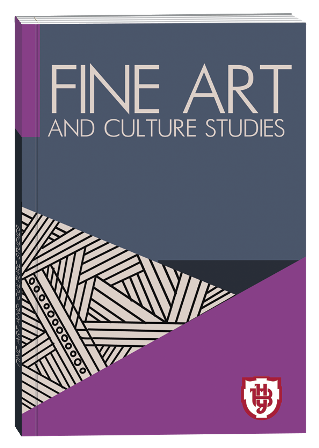THE FORMATION OF THE MODERNIST VISUALITY OF WOMEN'S PAINTING IN REPUBLICAN CHINA IN THE FIRST HALF OF THE 20TH CENTURY: THEMATIC AND GENRE REPERTOIRE
DOI:
https://doi.org/10.32782/facs-2024-2-9Keywords:
Chinese fine art, women's art, oil painting, modernism, artistic languages of modernism.Abstract
The purpose of the article: the problem of the thematic and genre repertoire in the painting of women artists in the context of the processes of forming the modernist face of Chinese fine art of the first half of the 20th century. Methodology. Historical-chronological and comparative analysis methods are used in the research. The method of figurative and stylistic analysis was used to interpret the works of art. Scientific novelty. The research made it possible to reveal and show the special role of a peculiar genre form of "hidden" self-portraiture (Pang Yulian, Sun Duochi). The meaning of the genre of still life, which was used by women artists not only as a means of demonstrating mastery of the oil technique, but as a space for experimentation with Western stylistic artistic languages: primarily Fauvism, post-impressionism, and expressionism, has been clarified and expanded. Conclusions. Based on the study of Chinese, the formation of the modernist face of female painting in Republican China of the first half of the 20th century is shown. It is revealed that the processes of the formation of modernism took place on the basis of the originality of the thematic and genre repertoire. The special role of figurative representation of female artists encouraged more active work in the self-portrait genre. An important theme in the works of Chinese female artists was female physicality, represented both in the manner of writing nudes (for example, in the genre of nude in the works of Fang Junbi), and in the form of presenting female imagery in genre paintings and portraits. Practical meaning. The researches of Chinese scientists introduced into scientific circulation can be used for further research into the problems of women's painting and art of later times, scientific and practical support of broad gender studies.
References
Котляр, Є.; Чжижун, Г. Джузеппе Кастільоне та формування нового канону жіночого портрету у китайському живописі XVIII століття. Наукові записки Тернопільського національного педагогічного університету імені Володимира Гнатюка. Серія «Мистецтвознавство». 2018. № 2. С. 284-294
Чжижун Г. Жіночий портрет у китайському живописі XX-початку XXI ст.: образно-стильова еволюція. Дис. …канд. мистецтвознавства за спеціальністю 17.00.05: образотворче мистецтво. Харківська державна академія дизайну і мистецтв. Львівська національна академія мистецтв. Харків; Львів, 2019. 432 с.
Qin R., Lin Z. Paris, Tokyo, Shanghai: Interaction and Communication of Chinese Modern Art. 2016 International Conference on Advances in Management, Arts and Humanities Science (AMAHS 2016). Atlantis Press, 2016. P. 369-374.
Sung, D. The Golden Key: Modern Women Artists and Gender Negotiations in Republican China, written by Amanda Wangwright. NAN NÜ. 2022. Vol. 24(1). P. 177-181.
Teo, P. Modernism and Orientalism: The Ambiguous Nudes of Chinese Artist Pan Yuliang. New Zealand Journal of Asian Studies. 2010. Vol. 12(2). P. 65-80.
Wangwright, A. Qiu Ti's Still Life and the Clash of Commodity, Domesticity, and Patriotism in 1930s Shanghai. Archives of Asian Art. 2022. Vol. 72 (1). P. 129-150.
Weidner, M. Women in the History of Chinese Painting. Views from Jade Terrace: Chinese Women Artists 1300-1912. 1988. P. 13-31.
Wright, A. S. Qiu Ti’s Contributions to Juelanshe and the Intersection of Modernist Ideology, Public Receptivity, and Personal Identity for a Woman Oil Painter in Early Twentieth-Century China. 2011. (Doctoral dissertation, University of Kansas).
Zhiyu, L. Knowing oneself and one’s home country: Reflections on Fang Junbi's experiences from the perspectives of emotions and feminist history. Chinese Studies in History. 2021. Vol. 54(4). P. 316-332.
舒晴. 民国那些女画家 民国六大新女性画家的艺术市场分析. 中国拍卖, 2013. 數字7. 頁44-49.
宁杭玲. 佩环簇簇尽仙才–民国时期的女性艺术. 新视觉艺术. 2013. 數字2. 頁20-22.
唐颖琼. 浅析民国时期女性画家的艺术特点与创作目的. 参花: 下. 2013. 數字 6. 頁61-68.
张红江, & 罗丹.浅析民国时期女性油画家艺术特征. 艺术评论. 2016. 數字 12. 頁159-161.
王若江. 她为徐悲鸿戴孝三年. 文史天地, 1995. 數字1. 頁23-27.
彭敏哲. 彭敏哲近代中国女性自画像的形象建构与自我书写. 社会科学, 2018. 數字8. 頁179-191.
丁言昭. 中国闺秀油画家关紫兰. 世纪. 2008. 數字1. 頁77-80.
丁言昭, & 马婕. 关紫兰: 远处的一盏明灯. 上海采风. 2010. 數字9. 頁40-47.
王斐. 中国早期油画女画家关紫兰的油画艺术. 时代文学. 2009. 數字15. 頁147-148.
杨培培, & 张康夫.论关紫兰艺术思想的形成及现实意义. 艺术研究: 哈尔滨师范大学艺术学院学报.
數字3. 頁16-18.
周龙. 民国女画家关紫兰的油画艺术. 明日风尚. 2016. 數字16. 頁49-50.
罗永生.重新 “发现” 关紫兰. 中国收藏. 2009. 數字9. 頁100-105.
方君璧. 吹笛女. 市场周刊 (艺术财经). 2012. 數字4.
王欣. 方君璧中西融合的艺术观研究. 现代装饰: 理论. 2013. 數字7. 頁210-214.
徐婷. 丘堤与决澜社. 现代装饰: 理论. 2011. 數字3. 頁92-95.
杨国丽. 丘堤绘画艺术研究综述. 报刊荟萃: 下. 2018. 數字2. 頁280-285.
王璐璐. 近乡情–孙多慈书画作品中的安徽情缘. 书画世界. 2014. 數字4. 頁35-42.
杨德忠. 孙多慈的爱情与艺术. 中国书画. 2005. 數字1. 頁150-151.
张健初. 孙多慈与徐悲鸿爱情画传. 长三角. 2011. 數字6. 頁84-85
江泓. 孙多慈: 徐悲鸿的红颜知己. 传奇故事: 百家讲坛中旬. 2009. 數字10. 頁60-63.







